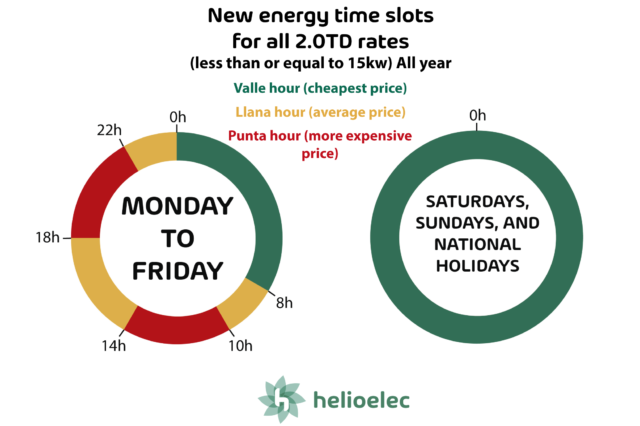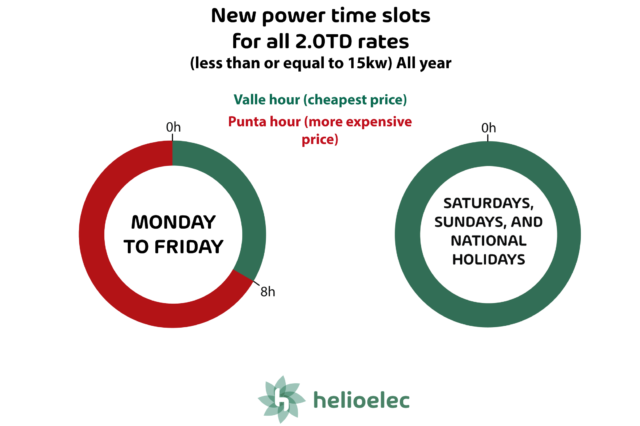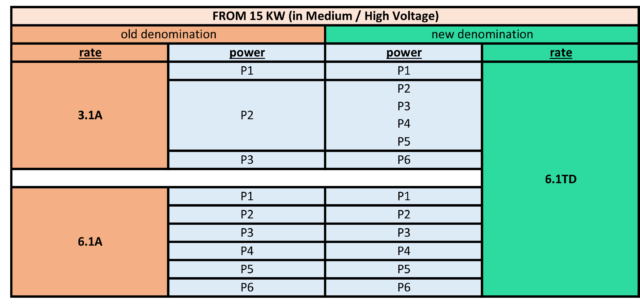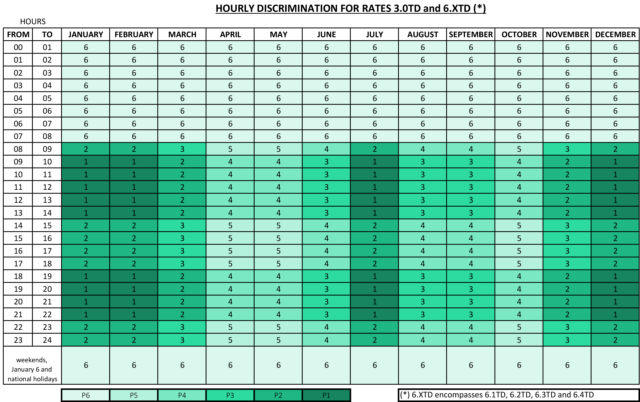Frequently asked questions
What tariff do I have?
The access charge is assigned by the distributor at the time of requesting a network supply point (ATR). This charge depends on the characteristics of the electrical installation, and the requested nominal power we need depending on the expected consumption. This information is reflected in the supply point details, which shows the power we have contracted for each period.
How much power have I contracted?
The contracted power defines the number of devices that can be connected simultaneously to the electrical current in a building or house; it is the amount of energy that a user can enjoy at the same time. It is measured in kilowatts (kW), and it directly affects the price of the fixed charge on the electricity bill.
Can I change the contracted power?
Power can be increased or decreased. To do this, the marketer opens a file with the distributor to change the fixed power charge. Decreasing power is a straightforward process. However, for a power increase, the installation needs to technically be able to withstand it. To verify that this is possible, the distributor requests the electrical documentation of the installation and, if everything is correct, it authorises the increase.
In line with regulatory standards, only two changes per year is allowed. This power adjustment has associated costs that need to be taken into account.
What is a penalty for power excess?
A penalty for power excess is applied to tariffs with an electrical power greater than 15 kilowatts (kW). Those with a lower contracted power have a Power Control Switch (ICP) that will cut off the electric power supply when it is exceeded.
Customers who have over 15 kW will have a maximum demand meter installed in their household or company. This device will measure the maximum power that has been used in each hourly period.
Less than or equal to 10 kW. This tariff can only be offered by reference marketers in the regulated market.
What does CUPS stand for?
CUPS is the acronym for “Universal Supply Point Code” in Spanish. This number identifies the physical address of an installation in the electrical network. The holder can change, but the code will always be the same while the installation is registered in the network.
What is the Social Electricity Subsidy (BONO SOCIAL)?
The Social Electricity Subsidy (Bono Social) is a discount on the cost of electricity. It is regulated by the Government to protect consumers that are in vulnerable situations. With the entry into force of Royal Decree 897 in October 2017, the requirements to be entitled to this subsidy changed.
Only reference marketers can process the Social Electricity Subsidy. At Helioelec we are a free market supplier and therefore we cannot supply PVPC rates (voluntary price for small consumers). Remember that if you are a beneficiary of the Social Bonus when contracting with Helioelec you will lose that condition.
What is an electricity distribution company?
A distribution company or distributor is the company in charge of physically taking electricity to the point of consumption. It is also responsible for the necessary electrical infrastructure, such as power lines and meters, and must guarantee quality and supply.
What is an electricity marketer?
An electricity marketer is a company that purchases the electricity on the market and sells it to users at a price previously established between both parties in a supply contract. There are two different types of marketers those that operate in the regulated market (reference marketers) and those that operate in the free market, which is the case of Helioelec.
How can I change my electricity marketer?
Changing electricity marketer is a straightforward process and is free for the customer. You can contact through the website of the chosen marketer to start the processing with the corresponding distribution company. If all is well, the distribution company will notify the activation of the new contract within 15 to 20 days.
Can I cancel a signed contract without a penalty?
The right of withdrawal is the power that consumers have to break a contract between two parties, without a justified cause, within the established period and without penalties. The only requirement is to notify the other party involved within the period established by law, which is currently 14 days.
If the supply had already started within this period, the customer would have to pay the corresponding cost of the service enjoyed until then. If the exercise of withdrawal takes place after the 14-day period, the marketer may apply penalties for early termination, provided it is not a renewal, in which case the low-voltage tariffs do not have an exit penalty clause.
What are time-based tariffs?
In the electricity market, there are different types of electricity tariffs established according to the supply voltage, which can be low-voltage tariffs (LV) or high-voltage tariffs (HV). In energy there is hourly discrimination of three or six periods in LV and six periods in high voltage. In power there is hourly discrimination in two or six periods in low voltage and six periods in high voltage.
How are consumption readings taken?
The distribution company is the owner of the electricity network infrastructure and usually of the meter as well, unless it is owned by the customer. The distribution company reads the meter and sends the data to the marketer so that it can bill the electricity supply to the customer.
What is estimated consumption?
If the distribution company does not have the actual reading data, it calculates an estimated reading based on its methodology. When the actual consumption data for that period are available, they are offset in the next electricity bill as an upward or downward adjustment.
What has HELIOELEC have to offer?
As a company authorised by the Ministry of Industry and Energy to operate in the free market, at Helioelec we manage, buy and bill the electricity of those people or companies that choose a new way of supplying energy. We generate our own electricity. We offer transparency, honesty and freedom when working to offer products adjusted to the needs of each customer.
Faithful to our principles, we give freedom to our customers. We do not apply exit penalties in our contracts, which means that anyone can stop using our services if they believe we have not performed as promised.
How can I contract with HELIOELEC?
To be able to contract your energy supply with us, you just have to contact us by calling 900 831 667 or by email at atencioncliente@helioelec.com. Formalizing the contract is a simple process that does not have any cost for the client.
What is a Free market and what is a Regulated market?
In 1992, a European directive made Spain modify the structure of the electricity sector. This process started in 1997 and continued progressively until 2009, when the concept of regulated tariff (Last Resort Tariff – TUR) was introduced by the Government for those consumers with a contracted power less than or equal to 10 kW, which lead to the differentiation between a regulated market and a free market. This liberalisation allowed the entry of new marketers, increasing the offers available to consumers, generating a free competition market with no other limitations than those imposed by the regulations of the electricity sector and giving the consumer the option to choose under which modality to contract their electricity at any time without limits. Sometimes, the free market can offer different conditions to those offered by the regulated Voluntary Price for the Small Consumer (PVPC) rate and vice versa. Those consumers who are in the free market can switch to the regulated market if their power does not exceed 10 kW and if it offers more advantages at a given time.
What does Voluntary Price for the Small Consumer (PVPC) mean?
The Voluntary Price for the Small Consumer (PVPC), previously known as the Last Resort Tariff (TUR), is established by the Ministry of Industry based on the evolution of the wholesale electricity market and only those users with a contracted electrical power of less than 10 kW can take advantage of it.
At Helioelec we are a free market trader and therefore cannot supply PVPC rates. Remember that if you are a beneficiary of the Social Bonus when contracting with Helioelec you will lose that condition.
How are the new 2.0TD rates that come into effect on June 1, 2021?
According to circular 3/2021 of the CNMC, as of June 1, 2021, all rates lower than or equal to 15kW, which are those that correspond to domestic environments, are renamed 2.0TD.
The main novelty of this tariff system is that it is divided into time bands that you must know to try to adjust consumption in the hours when energy and power are cheaper. It is easy!
How are the new rates above 15kW that come into effect on June 1, 2021?
According to circular 3/2021 of the CNMC as of June 1, 2021, all rates above 15kW have these changes imposed:
– Tariff 3.0A: now has 6 energy time bands and 6 power periods. It’s going to be called 3.0TD.
– Rate 3.1A: disappears and is included in rate 6.1TD.
– Rate 6.1A: it maintains the same format and is renamed 6.1TD.
Power adaptation:
The powers can only be contracted in increasing order (P1 ≤ P2 ≤ P3 ≤ P4 ≤ P5 ≤ P6).
Let’s see it with two examples:
1- Supply with 3.0A rate and with these contracted powers: P1: 10kW, P2: 15kW and P3: 20kW.
This supply will become the 3.0TD rate with the following powers: P1: 10kW, P2: 15kW, P3: 15kW, P4: 15kW, P5: 15kW and P6: 20kW.
2- Supply with 3.0A rate and with these contracted powers: P1: 10kW, P2: 20kW and P3: 5kW.
This supply will become the 3.0TD rate with the following powers: P1: 10kW, P2: 20kW, P3: 20kW, P4: 20kW, P5: 20kW and P6: 20kW.
The energy time bands are established as follows:
You don’t have to do anything initially. By default, the distributor will adapt the contracted power to you fulfilling the premise that appears in the previous tables. The contracted powers are may modify once every 12 months, with the exception of the transitional period for adaptation to the new toll structure, during which 2 changes are allowed.





